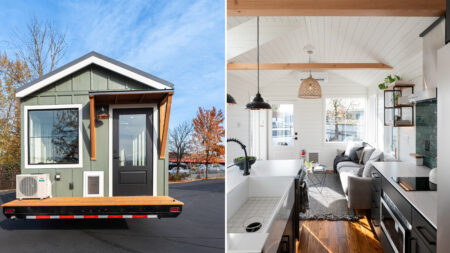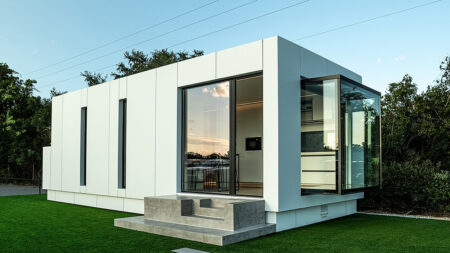The Institute for Advanced Architecture of Catalonia (IAAC), Barcelona, is known to give advanced architectural talent to the world. And I wouldn’t expect any less from the Barcelonan research institute. After all, it is where Antoni Gaudi spent his life pioneering Catalan Modernism. It seems the Catalan architect and designer inspired the young students at the IAAC, who have built a prototypical self-sufficient mobile cabin from dowel-laminated timber with an operable façade that opens up like a box to reveal the world of possibilities inside.
Dubbed the MO.CA (Mobile Catalyst), the tiny house on wheels uses ‘zero-kilometer’ natural materials and digital construction techniques for a sustainable form. This advanced project was perceived by students and researchers of the Master’s program in Advanced Ecological Buildings & Biocities at IAAC. The zero-kilometer dowel-laminated timber was acquired from Valldaura Labs in the National Park of Collserola, Barcelona, where it was sustainably produced.
The MO.CA has a versatile design setup, allowing it to be used for residential space, home office, workshops, concerts, or whatever you wish to do with it. The best part of this mobile home is that like its façade, the custom-designed furniture folds and stows away nicely when not in use.
Built on a 17.7-foot-long and 7.8-foot-wide trailer, the cabin is 11.8-foot-high, making it a typical tiny house with an operable exterior. It has glass doors and fabric layers that provide weather adaptability and merge indoor and outdoor spaces. Inside, it features two anchoring toolboxes with integrated utilities and living spaces designed for domestic activities. The central space is called the ‘reaction chamber’ which acts like the living room of a typical house to host gatherings. Flanking the social space are sleeping stations modeled after train bunks, a kitchen with necessities, a waterless toilet system, and a shower space to provide traditional home facilities.
The Mobile Catalyst tiny house is entirely solar-powered. It further makes use of self-sufficient elements such as water management and waste disposal to ensure a reduced carbon footprint. Moreover, it is designed within the trailer limitations and local regulations, which ensures its restricted footprint. The weight of the construction along with the trailer cannot go above 3 tons.
The sustainable features and lightweight build of the MO.CA are the epitome of a holistic design approach to mobile, downsized living and could pave the way to the future of the tiny house industry.




Via: designboom
Follow Homecrux on Google News!




